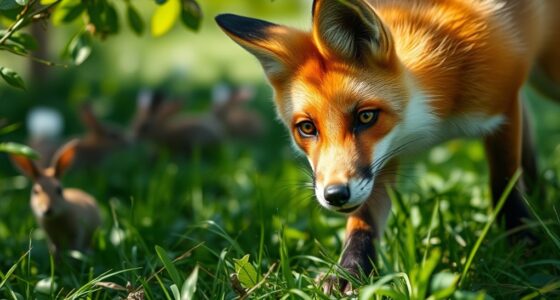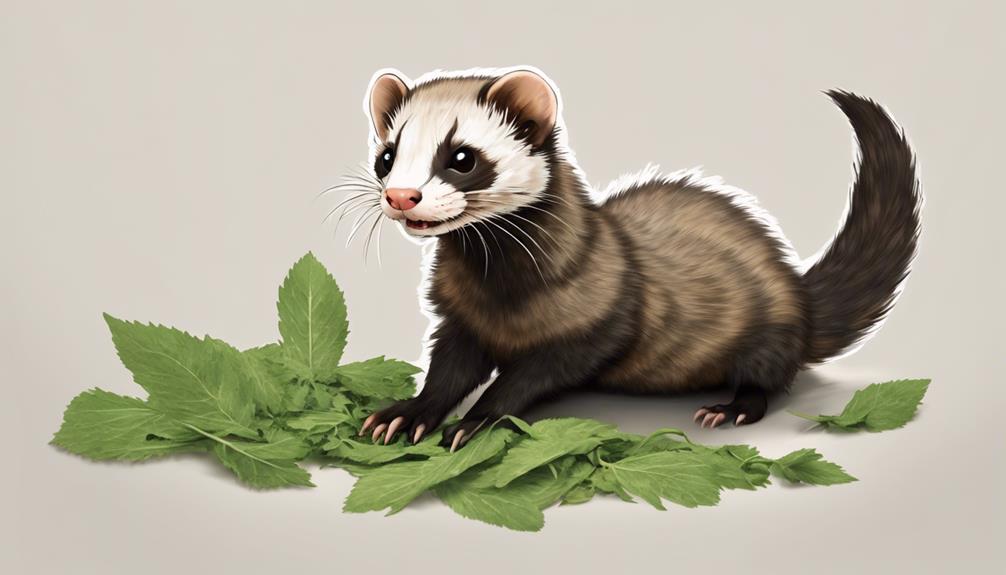Crows and ravens are among the smartest birds, known for their advanced problem-solving skills and tool use. They adapt quickly to different environments and showcase innovative behaviors to access food. Their communication abilities are impressive, with vocal mimicry and social recognition abilities that help them recognize human faces. These traits reveal a high level of cognitive function that rivals some primates. There's even more to uncover about their intelligence and adaptability, so keep exploring.
Key Takeaways
- Crows and ravens exhibit advanced cognitive abilities, including tool use and problem-solving skills comparable to great apes.
- Their innovative behaviors include bending sticks and using stones to acquire food and solve challenges.
- These birds demonstrate planning for future needs by saving tools, showcasing their intelligence and foresight.
- Crows and ravens possess sophisticated communication skills, including vocal mimicry and recognizing human faces based on past encounters.
- Their strong social structures and cooperative behaviors highlight their emotional intelligence and collaborative problem-solving capabilities.
The Cultural Significance of Crows and Ravens

Crows and ravens hold deep cultural significance across the globe, embodying a mix of power, mystery, and intelligence. For millions of years, these birds have fascinated humanity, inspiring myths and folklore that reflect their prominent status.
In Aboriginal culture, crows are sacred, symbolizing a spiritual connection to nature. Ancient Greeks saw them as omens, linking their presence to the supernatural and death.
With around 40 species inhabiting diverse regions from Europe to North America, their cultural impact is undeniable. You'll find that both crows and ravens often represent intelligence and adaptability in storytelling traditions.
With approximately 40 species across Europe and North America, crows and ravens are powerful symbols of intelligence and adaptability in culture.
Their greater ability to navigate complex environments further cements their roles as symbols of wisdom, making them powerful figures across various cultures.
Evolutionary Adaptation and Survival

Crows and ravens have adapted remarkably over millions of years, evolving rapidly to thrive in diverse environments.
Their physical traits, like elongated wings and larger bodies, have helped them compete for resources effectively.
Understanding these adaptations sheds light on their impressive survival and expansion across the globe.
Rapid Species Diversification
As habitats and climates shifted dramatically around 10 million years ago, crows and ravens underwent rapid evolutionary adaptation and diversification. This period marked a significant expansion of their geographic range, as they evolved traits like elongated wings and larger bodies to compete for resources in varied environments.
A study by Joan Garcia-Portas revealed critical genetic and physical traits, including beak size and brain volume, that shaped their adaptability. The impressive rates of diversification in these birds showcase their remarkable ability to thrive under changing conditions, surpassing many other bird species.
Their combination of physical adaptations and larger brain mass enhances their cognitive abilities, further supporting their survival and success in diverse ecosystems across the globe.
Physical Adaptations for Survival
While traversing diverse environments, crows and ravens have developed a suite of physical adaptations that enhance their chances of survival. Approximately 22 to 18 million years ago, these birds experienced rapid evolutionary expansion, leading to elongated wings and larger bodies, which help them compete for resources.
Their adaptability to changing habitats and climates resulted in high diversification rates, showcasing their resilience. You'll notice that their beak sizes and body structures have evolved to fit various ecological niches, allowing them to exploit different food sources and environments effectively.
This rapid adaptation outpaces that of both prehistoric and modern birds, underscoring their ability to thrive in a variety of conditions and solidifying their status as one of nature's most versatile survivors.
Cognitive Abilities and Problem Solving
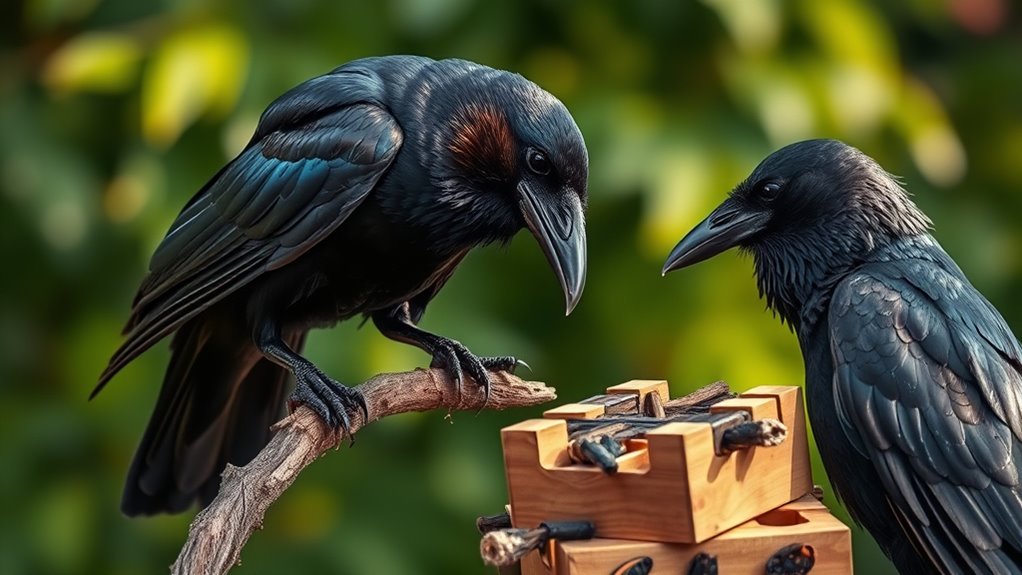
When it comes to cognitive abilities, crows and ravens truly stand out.
You'll find them using tools to solve problems and displaying impressive social intelligence.
Their ability to innovate in various situations showcases just how advanced their problem-solving skills really are.
Tool Use Innovations
Crows and ravens exhibit remarkable tool use innovations that highlight their cognitive abilities and problem-solving skills.
These birds not only create and use tools but also adapt them to meet specific needs. Here are some fascinating examples of their ingenuity:
- Crows bend sticks to extract insects from tree bark.
- Ravens use stones to crack open nuts.
- Crows understand water displacement, dropping stones to raise water levels and access floating food.
- They plan for future needs by saving tools for later use.
These behaviors showcase their advanced thinking and adaptability, pushing the boundaries of what we traditionally consider unique to humans and some primates.
It's clear that crows and ravens are truly remarkable problem-solvers in the animal kingdom.
Social Intelligence Display
The social intelligence of crows and ravens reveals just how sophisticated these birds truly are, as they display cognitive abilities that rival those of some primates.
Ravens, for instance, show problem-solving skills comparable to adult apes. Crows even mimic human speech, highlighting their ability to learn through social interactions.
When using tools, crows express happiness, demonstrating an understanding of cause and effect. Additionally, they can recognize human faces, distinguishing between friendly and threatening individuals in their surroundings.
This remarkable trait enhances their social dynamics and survival strategies.
With a large brain mass relative to their body size, crows and ravens exhibit innovative behaviors, adapting effectively to diverse habitats and enriching their social interactions.
Problem-Solving Skills
Social intelligence sets the stage for exploring the impressive problem-solving skills of crows and ravens.
These birds exhibit cognitive abilities that rival those of adult apes. Their advanced skills aren't just about intelligence; they also show emotional intelligence linked to their actions.
Here are some key points about their problem-solving abilities:
- Ravens possess cognitive skills comparable to adult apes, showcasing remarkable problem-solving.
- Crows express happiness when using tools, indicating their emotional connection to problem-solving.
- They can recognize human faces, adapting behavior based on individual interactions.
- Crows mimic human speech, demonstrating complex vocal learning and communication.
With their large brain mass relative to body size, crows and ravens are truly innovative problem solvers, adapting and learning in fascinating ways.
Communication Skills and Mimicry

While many birds communicate through simple calls, crows and ravens take it a step further with their impressive vocal abilities and mimicry skills. You might be surprised to learn that crows can mimic human speech, showcasing their complex vocal learning and adaptability.
Ravens, on the other hand, demonstrate cognitive abilities similar to adult apes, highlighting their advanced social intelligence. These birds don't just mimic sounds; they recognize human faces, adjusting their behavior based on individual interactions. This ability underscores their sophisticated communication skills.
Additionally, research suggests that crows experience happiness when using tools, linking their emotional states with their cognitive functions. Altogether, these traits reveal the remarkable social behaviors and intelligence that distinguish crows and ravens from many other bird species.
Tool Use and Innovation

Crows and ravens not only excel in communication but also showcase remarkable ingenuity when it comes to tool use. Their skills in this area highlight their impressive cognitive abilities.
You might be surprised to learn that:
- Crows can use tools, demonstrating problem-solving skills that rival great apes.
- Ravens fashion tools from twigs to extract insects from tree bark.
- Crows modify their tool use based on specific environmental challenges.
- Their large brain mass relative to body size is linked to their innovative capabilities.
These birds also exhibit happiness while using tools, indicating an emotional connection to their problem-solving activities.
This level of innovation and adaptability makes crows and ravens truly fascinating creatures in the animal kingdom.
Social Behavior and Recognition
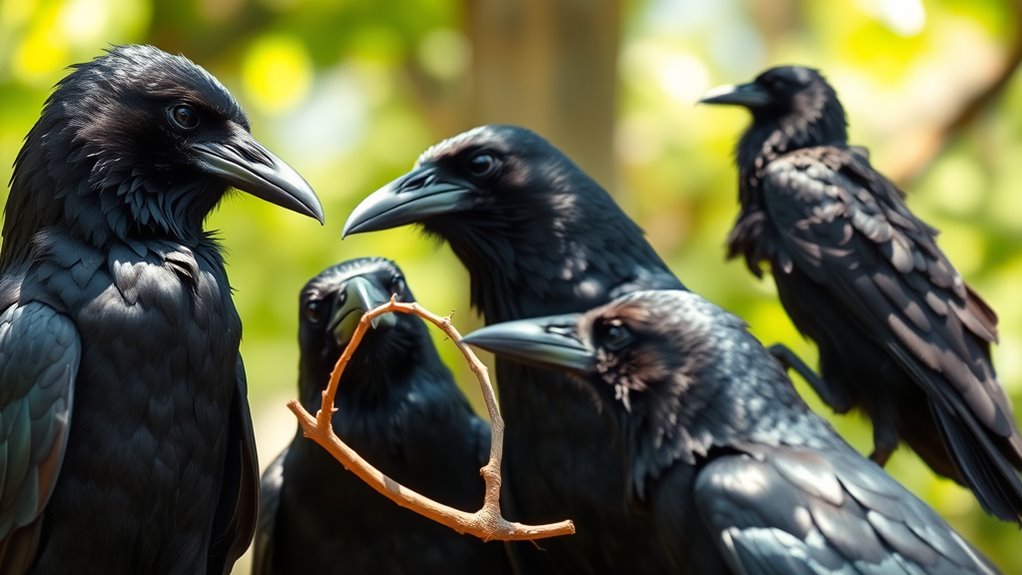
Understanding the social dynamics of crows and ravens reveals just how complex their lives really are. These birds form strong family bonds and practice cooperative breeding, showcasing their social intelligence. They can recognize and remember human faces, allowing them to navigate their environments more effectively. Vocal communication is key in their interactions, with different calls conveying various messages. They also engage in playful behavior, reflecting their ability to connect and enjoy each other's company. Ravens, in particular, demonstrate collaboration in problem-solving, further highlighting their sophisticated social structures.
| Behavior Type | Description | Example |
|---|---|---|
| Family Bonds | Strong ties within groups | Cooperative breeding |
| Face Recognition | Identifying humans | Remembering individual faces |
| Vocal Communication | Different calls for messages | Alarm calls |
| Play Behavior | Engaging in non-serious activities | Games with each other |
| Problem-Solving | Collaborating to solve challenges | Group tasks |
Physical Adaptations for Diverse Habitats
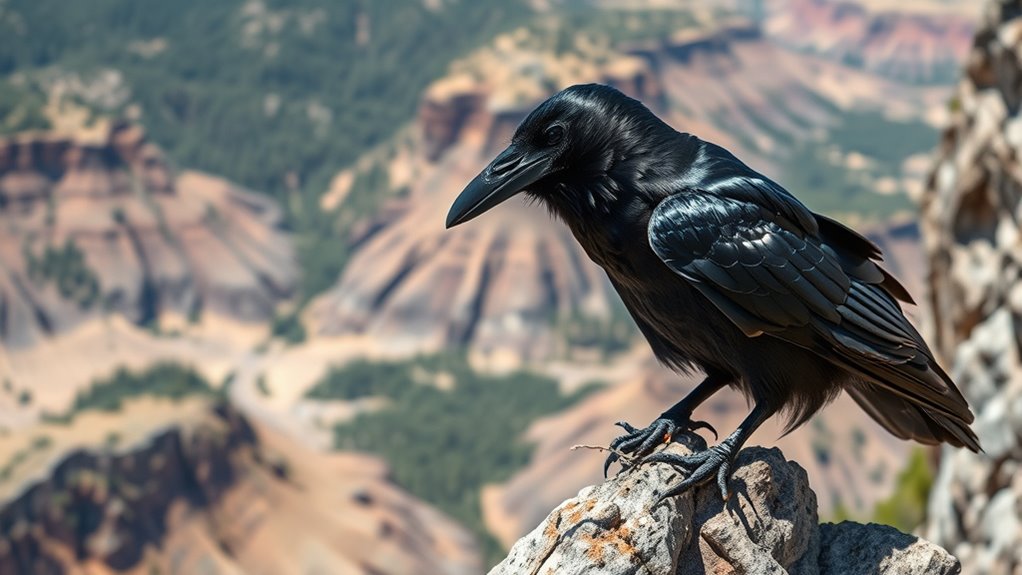
As they adapted to various environments, crows and ravens developed remarkable physical traits that enhance their survival.
These adaptations include features that help them compete for resources and thrive in diverse habitats.
Consider these key traits:
- Elongated wings for improved flight efficiency, allowing them to cover large distances.
- Larger body sizes that enable better heat retention in colder climates.
- Variable beak sizes tailored for different food sources, enhancing foraging success.
- Increased brain volume associated with complex problem-solving and adaptability.
These traits reflect their evolutionary success over the past 10 million years, showcasing their remarkable capacity to thrive across various ecosystems and respond to environmental challenges.
Research Findings on Species Diversification

Research into the diversification of crows and ravens reveals fascinating insights into how these birds have adapted over time. A thorough analysis of 46 species shows significant physical diversity, with variations in beak sizes, brain volume, and femur lengths. This suggests that crows and ravens have evolved specific traits to thrive in different environments.
Utilizing modeling software, researchers identified genes and traits that influence these physical characteristics. The study found that the highest rates of diversification were linked to their expansion into new habitats and climate changes.
Remarkably, crows and ravens adapted more quickly than other bird species over the past 10 million years, highlighting their remarkable capacity to cope with diverse habitats, which has been essential for their survival.
Future Directions in Corvid Research

While the impressive adaptability of crows and ravens has captured the attention of scientists, future directions in corvid research promise to explore deeper into the mechanisms behind their success.
You'll see researchers focusing on several key areas:
- Investigating the correlation between large brain mass to body size ratios and innovative learning behaviors.
- Examining how physical adaptations, like beak sizes and body structures, contribute to cognitive abilities.
- Understanding the genetic influences driving variations in crow and raven species across different climates.
- Exploring the role of social structures and interactions within corvid populations and their effects on cognitive development.
These studies aim to unravel the complexities of corvid intelligence, enhancing our understanding of their remarkable adaptability.
Frequently Asked Questions
How Intelligent Are Crows and Ravens?
You might be surprised to learn that crows and ravens are extremely intelligent. They solve complex problems and even use tools, which showcases their innovative thinking.
These birds can communicate effectively, mimicking human speech and recognizing individual faces. Their emotional intelligence shines through when they display happiness while using tools.
With a brain mass relative to their size that supports advanced learning, you can see why they adapt so well to different environments.
Which Bird Has the Highest IQ?
You might think the highest IQ in the bird world belongs to a parrot or a beloved canary, but it's actually the crow that often takes the crown.
With their impressive problem-solving skills and ability to use tools, these birds showcase remarkable intelligence.
You'll find that crows can even recognize human faces, adapting their behaviors based on past interactions.
Is a Crow as Smart as a 7 Year Old?
You might be surprised to learn that a crow's intelligence can indeed resemble that of a 7-year-old child.
They solve complex problems, use tools, and understand cause and effect.
When you observe their playful behavior and social interactions, it showcases their emotional intelligence.
What Is the Personality of a Raven Vs Crow?
When you think about the personalities of ravens and crows, you'll notice key differences.
Ravens tend to be more solitary and reserved, often displaying complex behaviors. They're like the quiet thinkers of the bird world.
Crows, on the other hand, are social and playful, thriving in groups. Their interactions are lively and engaging.
Conclusion
In the grand tapestry of nature, crows and ravens weave threads of intelligence and adaptability that captivate our imaginations. Their remarkable cognitive abilities and social intricacies paint a vivid picture of survival and innovation. As you explore their world, you'll uncover a rich narrative of communication and tool use, showcasing these feathered enigmas as the clever architects of their own destinies. The future of corvid research promises to reveal even more hidden gems, enriching our understanding of these avian marvels.





